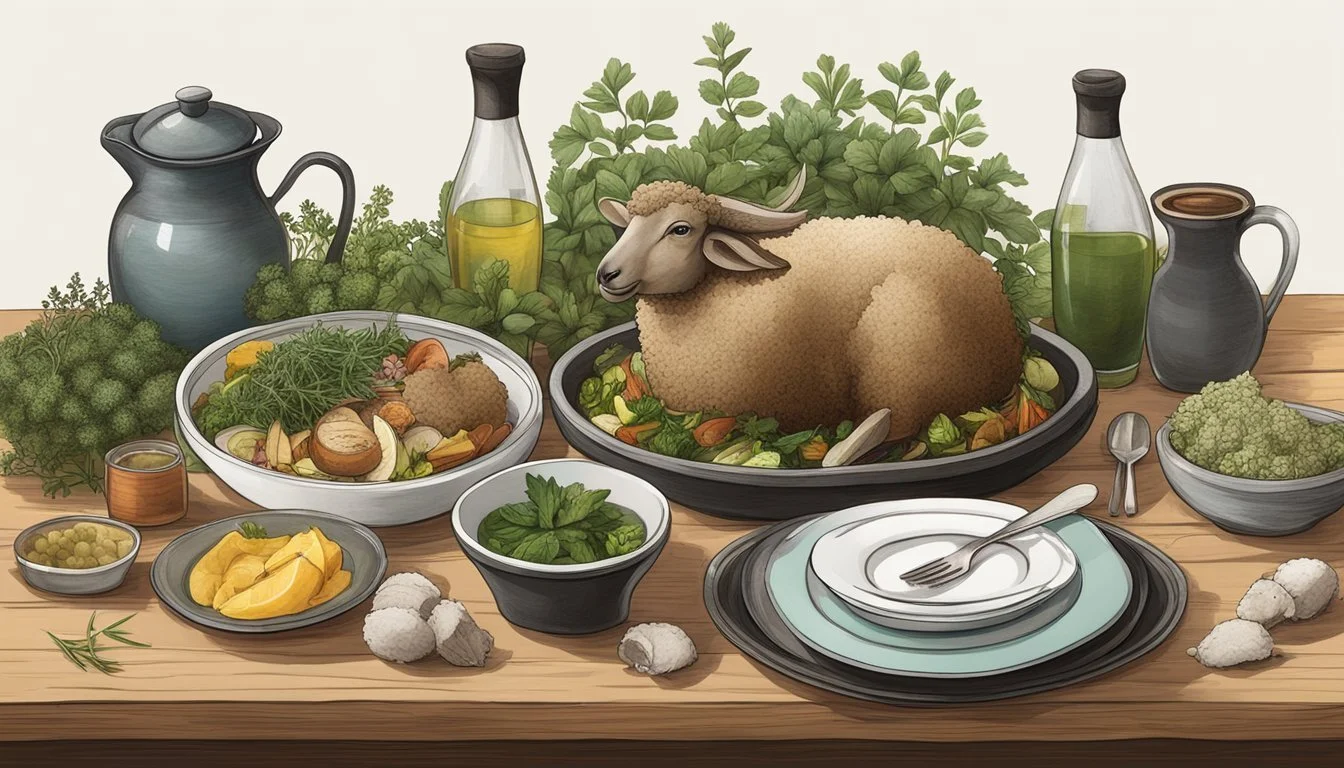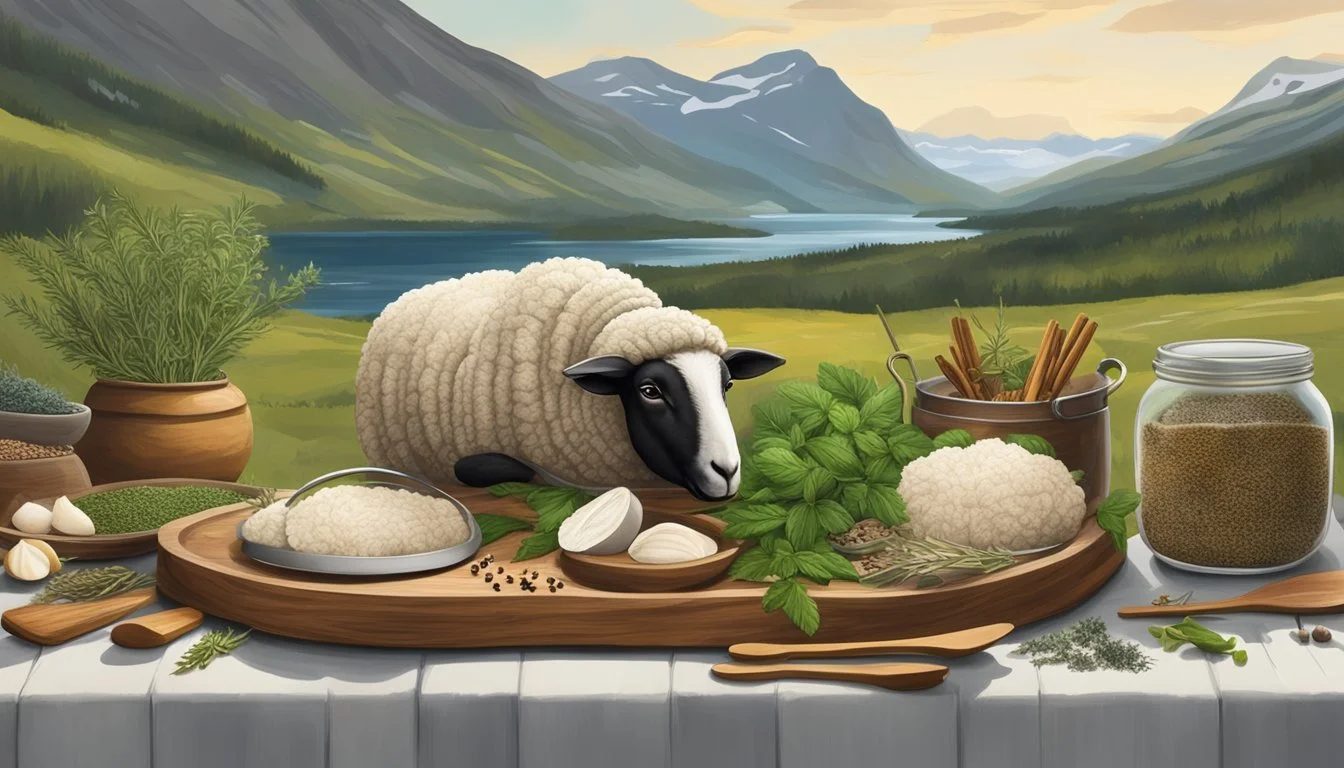Sheep's Head
A Traditional Delicacy in Norway Known as Smalahove—Culinary Heritage Explored
Sheep's head, known as Smalahove, is a traditional Norwegian delicacy with deep roots in the country's culinary history, particularly in the western regions. Once a common fare among the less affluent who keenly utilized every part of an animal, Smalahove today holds a place of cultural significance and is often associated with the winter holiday season. The dish consists of a sheep's head that is initially salted, then dried, and finally boiled or steamed until the meat becomes tender.
The preparation of Smalahove requires meticulous care, a process that underscores the Norwegian ethos of resourcefulness in cuisine. Every detail, from the drying of the head to the cooking time, is critical in achieving the desired flavor and texture. The dish is traditionally served with accompaniments such as rutabaga and potatoes, which complement the rich and distinct taste of the meat.
Consuming Smalahove is an experience steeped in tradition, frequently enjoyed in the company of friends and family. Its distinctive serving presentation, with the head placed whole on the platter, can be startling to the uninitiated. However, it is a testament to Norway's culinary heritage, offering a taste of the country's rustic past through a practice that has endured and transformed into a celebratory meal.
Historical Background
The historical roots of smalahove, a distinct Norwegian food tradition, stretch back centuries and encompass elements of cultural heritage and historical significance, reflecting the country's long-standing relationship with sheep farming.
Origin and Evolution
Smalahove originated as a dish among Western Norway's sheep-farming communities and has ties to the Viking Age. Initially a means to utilize every part of the animal, shepherds prepared smalahove by cooking the sheep's head over an open fire. Over time, this dish evolved from a shepherd's sustenance into a pre-Christmas delicacy that is particularly cherished in Western Norway.
Cultural Significance
The consumption of smalahove reflects Norway's cultural emphasis on resourcefulness and respect for livestock. As part of the country's cultural heritage, it symbolizes the importance of utilizing all resources to their fullest. Historically, the dish was associated with the lower classes, who could not afford to waste any part of the sheep. Today, smalahove holds a unique place in the nation's culinary traditions and is enjoyed as a festive meal with historical significance.
Norwegian Traditions
In Norway, traditions surrounding smalahove are closely linked to festive occasions, especially Christmas. Family and friends gather to share this meal, which is typically served with accompaniments such as rutabaga mash (swede) and potatoes. The preparation method has been passed down through generations, involving salting, drying, and often smoking the head before it is boiled or steamed until tender. The traditional knowledge and methods used to prepare smalahove are an important part of passing on Norway's cultural heritage.
Smalahove Preparations
Smalahove is a distinctive dish where precise preparation methods are key to achieving its unique flavor and texture. The preparation process involves specific ingredients and flavoring, along with time-honored salting and drying techniques, culminating in a boiling process that renders the meat tender and ready to serve.
Ingredients and Flavoring
In preparing Smalahove, the primary ingredient is the head of a sheep, which is salted and dried before cooking. Flavoring is relatively simple, focusing on enhancing the natural taste of the meat. Common ingredients and flavorings include:
Salt: Essential for curing the head.
Water: Used to boil the head.
Black Pepper: Often added for additional flavor.
Butter and Cream: May accompany the dish when served.
Salting and Drying
The sheep's head is first cleaned thoroughly. It is then salted to act as a preservative and flavoring agent. Following the salting, the head is left to dry. The traditional drying process includes:
Air-Drying: Preferably in cold, dry conditions typical of regions like Voss.
Time Frame: The head is dried until it has lost a significant amount of moisture, which can enhance the flavor profile.
Boiling and Serving
After drying, the Smalahove needs to be boiled:
Preparation: The dried and salted head is placed in a large pot of boiling water.
Cooking Time: It is typically boiled for 3-4 hours. The goal is to ensure that the texture of the meat, including the tongue, cheek, and other facial muscles, is tender enough to easily separate from the bone.
Brain Removal (Optional): Some preparations may remove the brain before boiling.
Serving: Smalahove is traditionally served with accompaniments like:
Boiled potatoes
Mashed rutabaga, enhanced with a mix of butter and cream for a creamy consistency
The eyes, ears, and fatty tissues may also be consumed, although this varies based on personal preference and local customs.
Through this meticulous process, Smalahove exemplifies the unique character and resilience of traditional Norwegian cuisine, delivering rich, savory flavors steeped in cultural heritage.
Conventions and Regulations
Norway maintains specific health regulations and traditional methods to preserve the integrity and safety of Smalahove, a delicacy traditionally consumed before Christmas.
Health and Safety
To ensure public health, Norwegian food safety authorities enforce regulations on the preparation of Smalahove. These standards are in line with the European Union (EU) guidelines for the prevention of prion diseases, such as scrapie in sheep, which is a concern due to the use of sheep's head in the dish. Each sheep head is thoroughly inspected and the preparation process is meticulously monitored to prevent any risks associated with prion diseases.
Scrapie Monitoring: Norway follows strict surveillance programs for scrapie in sheep.
EU Directive Compliance: Preparation adheres to the EU's regulations for food safety.
Preservation Methods
Traditional preservation methods play a critical role in the distinct flavor of Smalahove, while simultaneously conforming to safety standards. These methods include salting, smoking, and drying the sheep's head to achieve the desired culinary quality.
Salting: Impedes bacterial growth and enhances flavor.
Smoking: Imparts a characteristic aroma and further preserves the meat.
Drying: Reduces moisture content to prevent spoilage.
These preservation techniques not only assure prolonged shelf life but are also integral to the dish's authenticity, ensuring Smalahove's place in Norway's culinary tradition while aligning with modern food safety practices.
Culinary Context
Smalahove holds a distinct spot within the Norwegian culinary heritage, particularly as a festive dish enjoyed around Christmas time. The preparation and consumption of this traditional Norwegian delicacy are deeply entwined with local traditions and customs.
Occasions and Festivities
Smalahove is traditionally associated with the festive season, particularly Christmas. In Western Norway, enjoying smalahove is a seasonal highlight and often accompanies local festivals. Historically, it was customarily eaten before Christmas, but today it may also be served during other celebrations, including Easter festivities.
Pairings and Accompaniments
The dish is commonly served with boiled potatoes and mashed rutabaga. Beverage pairings typically include beer and aquavit (Akevitt in Norwegian), a spirit that is a staple in Norwegian festivities. These traditional accouterments enhance the flavor of the smalahove and reflect the culinary practices of Norway.
While lutefisk, ribbe, and pinnekjøtt may also be enjoyed during holiday feasts in Norway, smalahove distinguishes itself with its unique presentation and taste, capturing the essence of Norwegian tradition and culinary heritage.
Modern Perspectives
Smalahove has transcended its rural Norwegian origins to become a cultural symbol and a draw for both domestic and international audiences interested in culinary traditions.
Tourism and Promotion
Tourism in Norway has greatly benefited from the country's emphasis on culinary heritage, with Smalahove taking center stage as a unique aspect of Norwegian cuisine. Restaurants, particularly those in western regions and at Smalahovetunet — a farm dedicated to the tradition — actively promote the dish to tourists. They offer an authentic Norwegian experience that not only involves tasting but also learning about the preparation and cultural significance of Smalahove.
Tour operators and travel guides often highlight the dish as a must-try experience, creating a kind of bucket list item for food enthusiasts. Cultural festivals and food tours specifically include Smalahove to provide a holistic and immersive experience into Norwegian food culture.
Contemporary Reception
Among locals, Smalahove maintains its status as a dish tied to tradition, typically consumed during the pre-Christmas season. While some Norwegians hold the dish close as part of their identity and gastronomic history, others regard it with a mix of curiosity and hesitation, reflecting the universal trend where generations vary in their taste preferences.
The impact of the dish on Norwegian culinary traditions cannot be understated; it serves as both a link to the past and an evolving practice, with chefs and enthusiasts experimenting to balance traditional methods with modern tastes. Restaurants across Norway have maintained the core aspects of the traditional Norwegian recipe, while also adapting the presentation and accompaniments to suit a more contemporary and broad audience, thus ensuring that Smalahove remains relevant in today's culinary discourse.
Ethical and Environmental Considerations
Traditional delicacies often reflect a region's values around sustainability and waste utilization. Smalahove is no exception, encapsulating Norway's emphasis on resourcefulness and ethical culinary practices.
Sustainable Practices
In preparing Smalahove, chefs emphasize resourcefulness, ensuring that every part of the sheep's head is used or processed in an environmentally conscious way. For example, removing the brain and fleece are steps done with care, often by seasoned professionals who understand the value of minimizing waste.
Resource Utilization:
Brain removal: ensures no part of the sheep's head goes underutilized.
Fleece handling: conducted in a manner that considers potential secondary uses or safe disposal.
The tradition of Smalahove is not just about maintaining culinary heritage; it embodies a commitment to ethical use of animals, where the aim is to honor the sacrifice by utilizing every part thoughtfully.
Culinary Waste Management
Meat Consumption: After boiling, the tender meat is served on a platter, showcasing a presentation that honors the animal.
Waste Processing:
Bones: Used for stocks or disposed of responsibly to minimize environmental impact.
Fleece: If not repurposed, is disposed of in an eco-friendly manner.
The conscious approach to culinary waste management ensures that the tradition of Smalahove aligns with Norway's modern environmental ethics. This practice of utilizing the entirety of the sheep's head reflects a broader national principle of reducing waste wherever possible.




